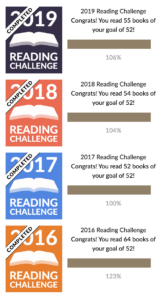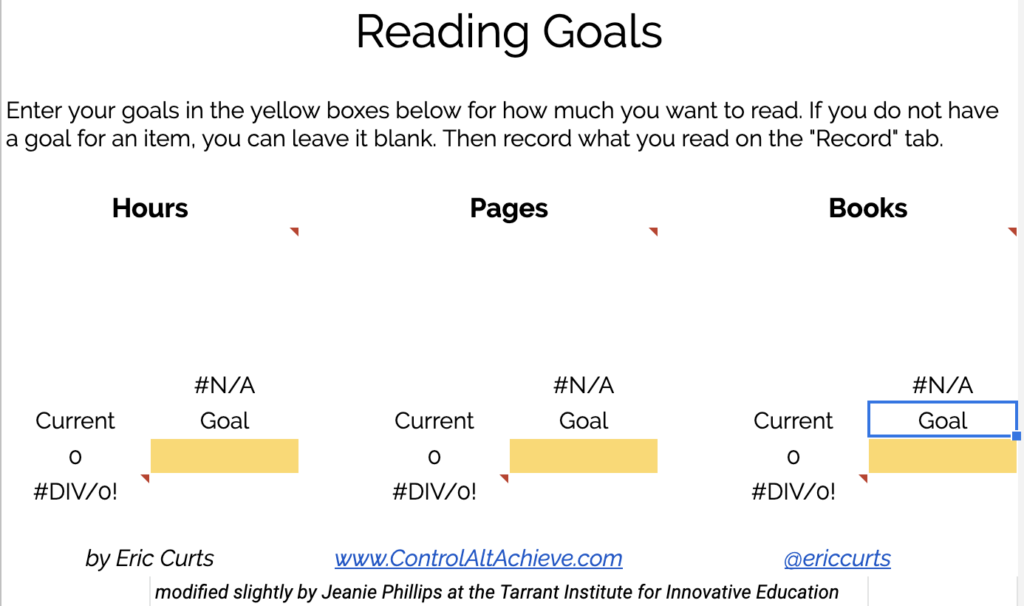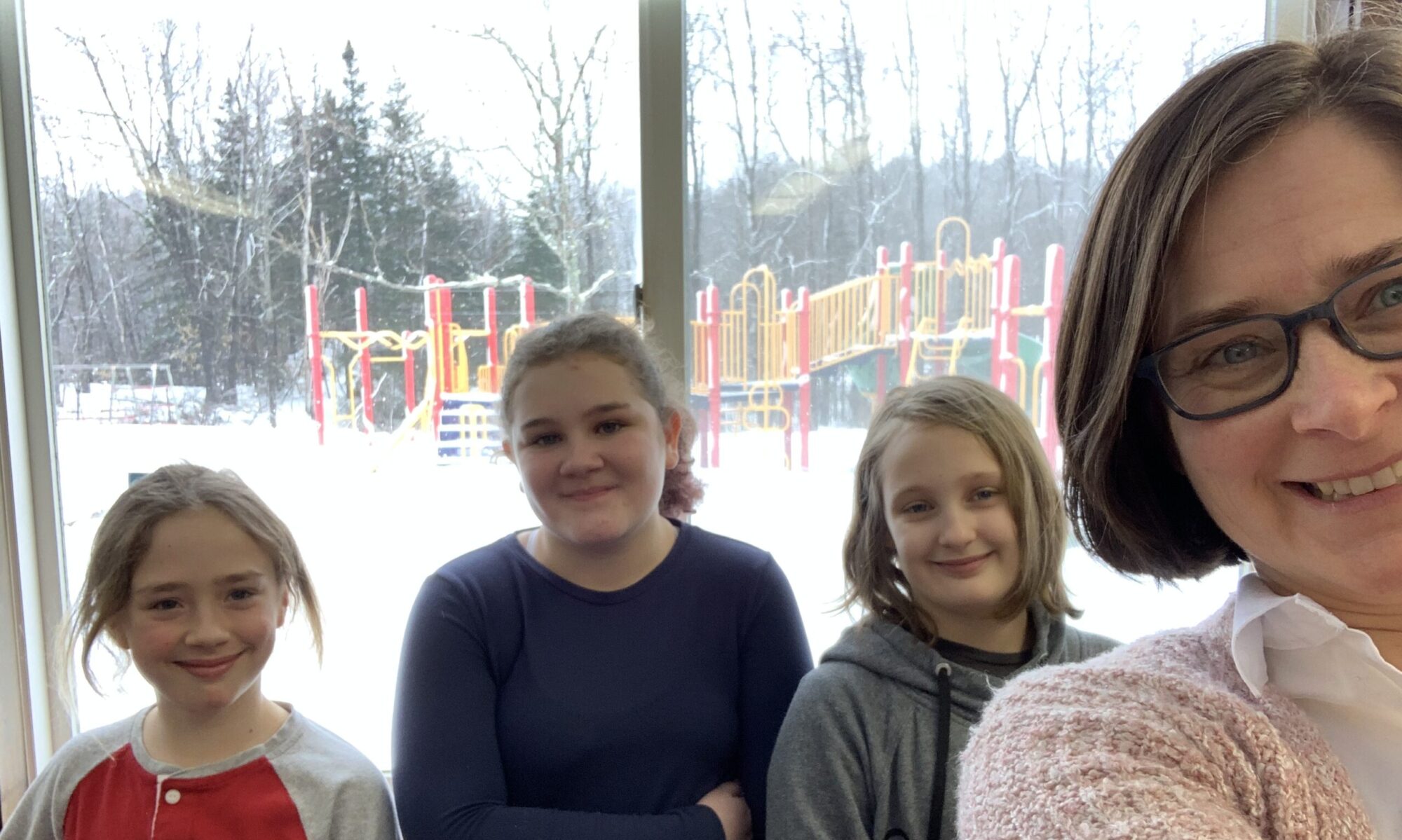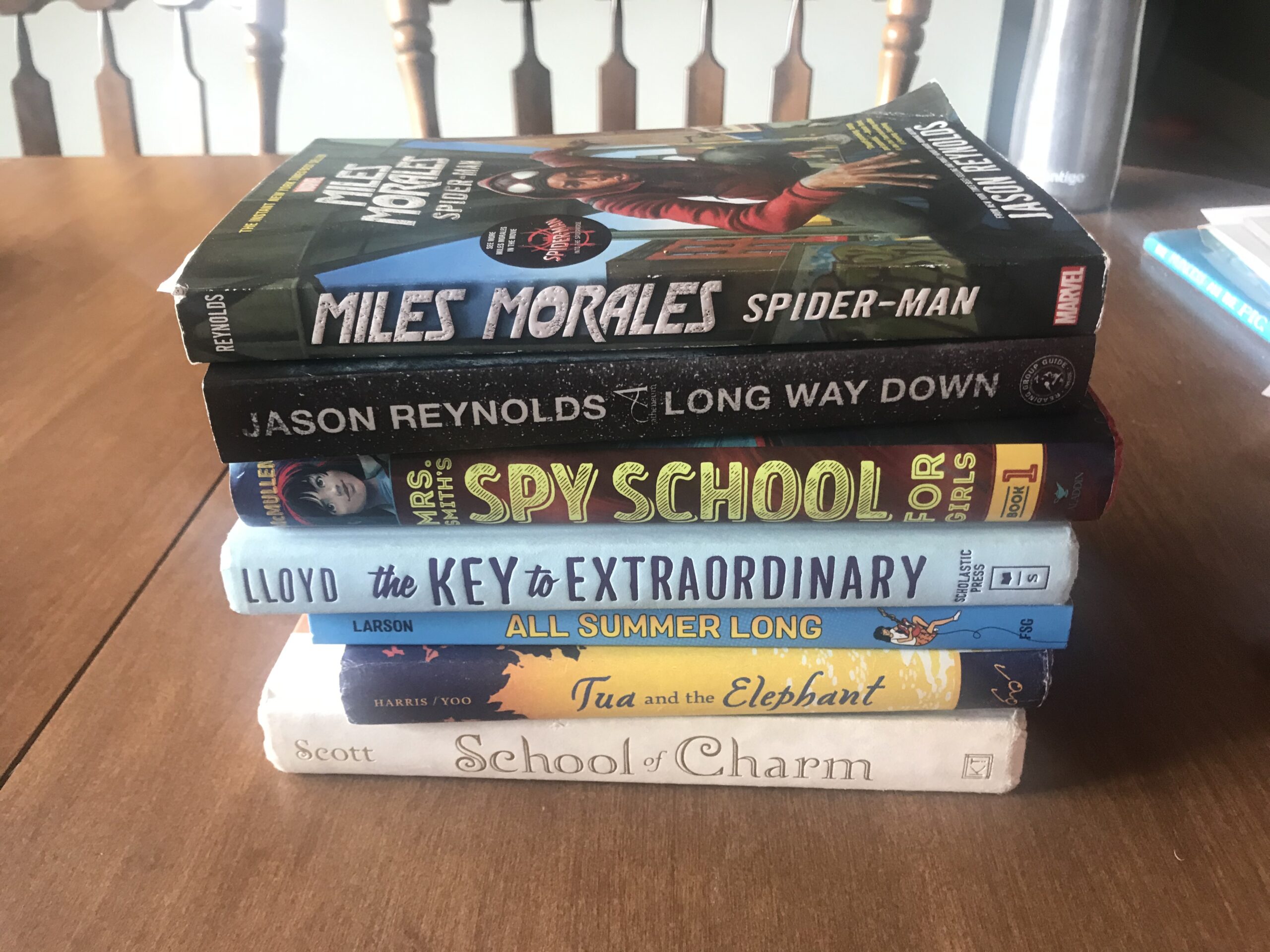I am NOT a fan of mandatory reading logs.
I am, however, a huge fan of reading for pleasure. Stories, real or imagined, build empathy, connect us with the broader world, and help us understand our own lived experience. Getting lost in a book is a real joy, one even the most reluctant readers can experience, as I learned in my many years as a school librarian.
Reading logs, on the other hand, can turn a fun activity into a chore and kill a love of reading. They foster compliance over joy. And they are often tied to extrinsic motivators: grades, rewards, prizes. All of this sends a message: reading is a chore. (For more on the harms of reading logs check out this Atlantic article or this blog post by Pernille Ripp.)
But I am a fan of goal-setting.
Like countless Goodreads users (including many #vted teachers, librarians, and students), I set a reading goal each year: 52 books. Every. Single. Year. For the last 5 years!

I don’t feel the need to up my goal, to beat a past record, or to compete with others.
I just know that a regular habit of reading feels good and that a book a week seems to be the right number for me. Goodreads helps me track my reading, and that keeps me from falling into a reading slump for too awfully long. (You know… that moment you hit when you finish a great book and are worried nothing else will ever compare… that kind of reading slump.) I don’t have evidence, but I think it’s made me a more self-directed reader!
Self-direction and reading can go hand in hand
After all, self-direction is all about setting personal goals. And about monitoring your progress, adapting and strategizing to meet your goal, and exercising choice over how you get there.
I reach my personal reading goal by:
- listening to audiobooks
- giving up on books I am not enjoying
- and including a wide variety of texts: professional books, fiction, poetry, graphic novels, and even the occasional picture book.
Keeping track of my reading keeps me on track!

So, what might goal setting look like for middle school readers?
Well, a year is a long (looooong) time. Eric Curts of Control-Alt-Achieve has created a reading goal and record document that help readers break their goals into more manageable chunks (brought to my attention by Mount Holly Elementary School teacher Margaret Dunne). Learners can set goals for the number of hours, pages, or books they want to read, or a combination of these.
This definitely ISN’T just an online version of a pencil and paper, fill in the blanks reading log. Rather, it’s a goal-setting, monitoring, and progress charting machine! It helps readers see a visual representation of the strides they are taking towards their goal. It makes it possible for users to adjust their goal as they see fit. And it allows them to document their reading such that they can identify and address any obstacles they encounter as they work to meet their goal.
I’ve modified it slightly for use in #vted schools:

Goal-setting is a process
I think giving students an opportunity to set their own reading goals and monitor their progress can be an important step towards students become lifelong readers. And I can imagine that this process will look very different for different students. Certainly, there will be some who set an ambitious goal and meet it. Others may need to adjust their goals, course correcting as they realize that their goals were too easy or too ambitious. This is one step along the way to getting better at setting goals, developing a sense of agency, and exercising their rights as readers.
Here is a screencast showing how students might use the Reading Goals google sheet to set goals and celebrate their progress:

Conferencing with readers about reading and self-direction creates powerful synergy.
Imagine a 1:1 conversation with a reader.
They spell out their reading goal and share their progress.
Perhaps they talk about where they got stuck: the wrong (boring) book, waiting to read until bedtime when they are tired, or getting interrupted by a sibling.
And they celebrate their successes: the time they got so swept away by the story that they read for over an hour, when they stopped reading the boring book and chose a magazine instead, or the author they discovered who makes them laugh out loud.
The goal of a conference is empowerment, not surveillance. Instead of focusing on the hours the student spent reading, the teacher focuses on the student’s self-direction. How they adjusted their goal or their strategies for reaching it, what they learned by monitoring their progress, how they managed to overcome obstacles. Perhaps the teacher asks questions to deepen reflection, or suggests other ways to deal with barriers to reading, helping students grow as both self-directed learners and as readers. Ultimately, the two connect reader to reader!



Question! Do you have any advice on how to avoid feeling disappointed when your reading log shows you’re falling behind with your goal? I struggle with that and I’m slightly older than a middle grades student.
Great question! Self-direction is a complicated thing! Setting a goal is part of the process, but so is reflection. You might start by reflecting on your goal to see if it is a “Goldilocks” goal, not too hard and not too easy. If your goal is too challenging, it will feel unattainable. A “Goldilocks” or “just right” goal should make you have to work, but should also feel doable. (I will never be one of those people who set a reading goal of 100 books – that is just too much for me!)
Other aspects of self-direction include monitoring and reflecting on progress, trying different strategies, and adapting as you go. Can you identify a specific obstacle? The book? The time of day you read? If so, how might you find a way around, over, or through that obstacle? When I’m stuck I usually try a completely different kind of book, or reread an old favorite. Once you find a way to make progress, reflect on that too! Why did it work? What can you learn from overcoming the obstacle. (Yup, it’s really all about reflection!)
Incredible inquiry! Self-heading is a confounded thing! Defining an objective is a piece of the procedure, however so is reflection. You may begin by thinking about your objective to check whether it is a “Goldilocks” objective, not very hard and not very simple. On the off chance that your objective is excessively testing, it will feel out of reach. A “Goldilocks” or “on the money” objective should cause you to need to work, yet ought to likewise feel possible. (I will never be one of those individuals who set a perusing objective of 100 books – that is simply a lot for me!)
Different parts of self-bearing remember checking and reflecting for progress, attempting various procedures, and adjusting as you go. Would you be able to distinguish a particular impediment? The book? The hour of day you read? Assuming this is the case, by what means may you discover a path around, finished, or through that hindrance? At the point when I’m stuck I normally attempt a totally unique sort of book, or rehash an old top choice. When you figure out how to gain ground, consider that as well! For what reason accomplished it work? What would you be able to gain from beating the impediment. (That is correct, it’s actually about reflection!)
I agree that reflection is so important! Thank you for sharing your thoughts.